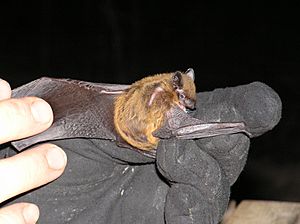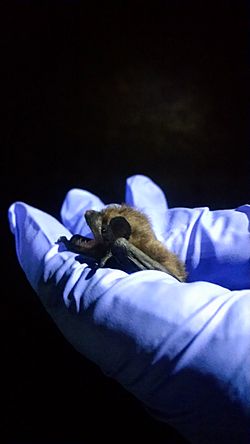Evening bat facts for kids
Quick facts for kids Evening bat |
|
|---|---|
 |
|
| Conservation status | |
| Scientific classification | |
| Genus: |
Nycticeius
|
| Species: |
humeralis
|
 |
|
The evening bat (Nycticeius humeralis) is a type of bat found in North America. These bats hunt at night. They mostly eat beetles, moths, and other flying insects.
Contents
About the Evening Bat
The evening bat is a small animal. It usually weighs between 7 and 15 grams. You can find these bats across much of the midwestern and eastern United States. Their forearms are about 34–38 millimeters long.
Most evening bats are brown. The tips of their back hairs are light gray. The rest of the hair is dark brown. They have wide, dog-like noses. They also have special glands on their faces. Evening bats can look like young big brown bats. However, evening bats are smaller.
Body Features
Evening bats have strong jaws. This helps them eat insects. They have a small, round part of their ear called a tragus. The shape of this tragus helps tell them apart from other bats. For example, it helps tell them apart from bats in the Myotis group. Their skull has one upper front tooth on each side. They also have four molar teeth for grinding food.
Evening Bat Life
Evening bats do not live as long as some other bats in their area. They usually live up to 6 years. But most of them live only about 4 years. They have more babies than many other bats. This might be why they have a shorter life. Bats that have only one baby a year need to live longer. This helps them have as many young as a bat that has two or three babies each year.
Reproduction
Evening bats mate in the fall and winter. The male's sperm is stored by the female until spring. Then, the eggs are fertilized. Female bats gather together in May. They form groups called maternity colonies. These groups can have from 15 to 300 female bats.
About 90% of the females give birth to twins. Sometimes they have one baby, or even three. It is most common for mothers to nurse their own babies. But sometimes, other female bats will nurse babies that are not their own. The baby bats, called pups, can fly about a month after they are born. They stop drinking milk from their mothers within 42 days. Female pups often return to the same place where they were born to have their own babies when they grow up. This is called natal philopatry.
Diet
These bats eat many different kinds of insects. In places like Indiana and Illinois, they mostly eat beetles. This includes the spotted cucumber beetle. This beetle is a big problem for farmers. In southern Illinois, the spotted cucumber beetle makes up almost 25% of the evening bat's diet. They also eat ground beetles and scarab beetles. Moths are another important food for them. They also eat bugs, winged ants, and flies.
Evening bats share their hunting grounds with other bats. For example, they share with the eastern red bat and Seminole bat. Even though they hunt in the same places at the same time, these bats eat different insects. This helps them all find enough food.
Where Evening Bats Live
At first, people thought evening bats only lived in the southeastern United States. But now we know they live much farther north. They have been found breeding as far north as Michigan. They also live as far west as the 100th meridian.
Evening bats sleep in many different places. They can be found in Spanish moss, under tree bark, inside tree holes, and even in buildings. In Georgia, evening bats like to hunt for food in pine forests. They also like areas near rivers and open fields. An evening bat's home area is about 300 hectares. This is about 1.15 square miles. Evening bats are not found in the northern parts of their range during winter. This means that some evening bats likely travel to warmer places for the winter.
Conservation Status
The evening bat is considered endangered in the state of Indiana. This means there are very few of them left there. Here is a list of their status in different states:
| State | Conservation Status |
|---|---|
| Alabama | Lowest Conservation Concern |
| Arkansas | Not listed |
| Florida | Not listed |
| Georgia | Not listed |
| Illinois | Not listed |
| Indiana | State Endangered |
| Iowa | Not listed |
| Kentucky | Threatened |
| Kansas | Not listed |
| Louisiana | Not listed |
| Maryland | Not listed |
| Michigan | Threatened |
| Minnesota | Not listed |
| Mississippi | Not listed |
| Missouri | Not listed |
| Nebraska | Not listed |
| North Carolina | Not listed |
| Ohio | Species of Special Interest |
| Oklahoma | Not listed |
| Pennsylvania | Not listed |
| South Carolina | Not listed |
| Tennessee | Not listed |
| Texas | Not listed |
| Virginia | Not listed |
| West Virginia | Not listed |
| Wisconsin | Not listed |
See also
 In Spanish: Nycticeius humeralis para niños
In Spanish: Nycticeius humeralis para niños



